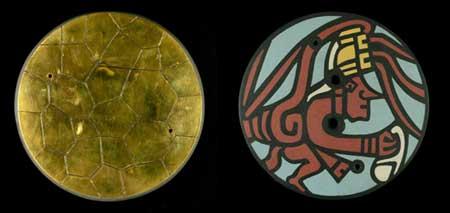Blake de Pastino
Source - http://westerndigs.org/mesoamerican-fools-gold-mirrors-found-in-arizona-reveal-ties-to-ancient-mexico/
Archaeologists exploring the ties between ancient cultures in the Southwestern U.S. and central Mexico have turned their attention to some unusual artifacts excavated in Arizona: more than 50 mirrors encrusted with the brilliant mineral pyrite, crafted in distinctly Mesoamerican styles.
The mirrors were originally unearthed in the 1930s and 1960s, during excavations of a major settlement of the Hohokam culture now known as Snaketown.
Most of the mirrors were found broken, burned, and buried with cremated human remains, with 36 mirrors having been discovered in 16 separate graves.
They were just one of the many signs of cultural interaction from Mesoamerica discovered at Snaketown — along with ceremonial ball courts, copper bells, and the remains of colorful macaws.
But until an effort was undertaken in 2001 to analyze the grave goods and repatriate them to the modern Gila River Indian Community, the pyrite mirrors went unstudied.
“I thought that the pyrite mirrors were a very interesting topic and that I’d find a lot of information on them,” said Dr. Emiliano Gallaga of Mexico’s National Institute of Anthropology and History, who took part in the repatriation project.

Reproductions of the front and back of a Mesoamerican pyrite mirror found at a Hohokam site in Arizona (Arizona Museum of Natural History)
“But with time, I found that everybody mentioned them, but there was no research about them.”
So Gallaga documented the mirrors’ sizes, shapes, materials, and methods of manufacture, with a view to determining where they were made, how, and by whom.
His analysis revealed that the mirrors were likely created in central Mexico from local materials, in a painstaking, time-consuming process that made them costly status symbols.
“Today, a mirror is a normal item of our daily life, but in the past, an item that could reflect an image was really expensive.
“According to our research, a single, small mirror could need 900 to 1300 hours, or 110 to 160 days, for a single craftsperson to do. So they are expensive to make.”
Early accounts and depictions of mirrors used among the Olmec, Maya, and Aztecs showed that they were often worn by elite members of society as ornaments, sometimes on the chest, other times on a belt at the base of the back, or on headgear.
“Mirrors were not only an item to see yourself; they were also portals to another dimension, to the ancestors, and a prestige item too,” Gallaga said.
Radiocarbon dates associated with the burials dated the mirrors from between 650 to 950 CE, a broad range from the Classic Period of Mesoamerica, when the Maya network of city states and the metropolis of Teotihuacan were at their peaks.
What’s more, the techniques used to make them — with delicate flakes of pyrite glued to sandstone or other rock with adhesive likely made from tree resin — bear the distinctive signs of Mesoamerican craftsmanship.
This, combined with the fact that there were no known deposits of pyrite, also known as fool’s gold, that were used by the Hohokam, suggest that the mirrors were made much farther south from where they were buried.